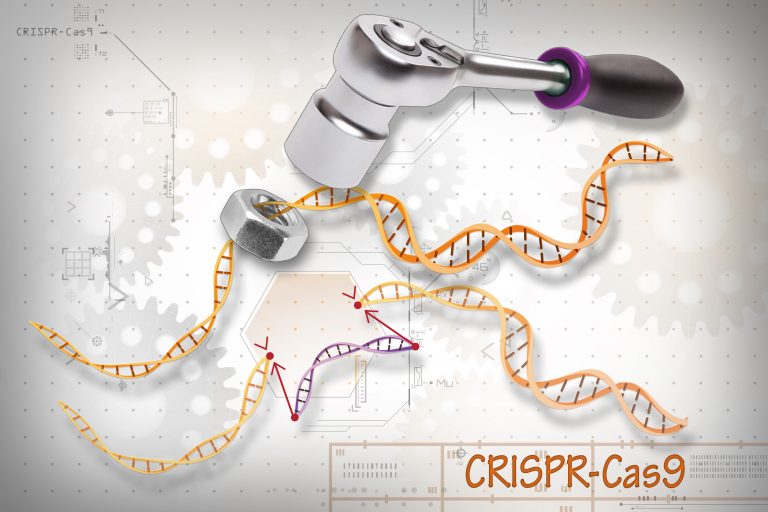Written by Dr. Marija Cvetanovic Edited by Dr. Ronald Buijsen
Researchers from the University of California show they can “edit” the Frataxin gene in human cells from Friedreich’s Ataxia and transplant them into mice. This lays the groundwork for this method to be tested for safety.
Friedreich’s ataxia is a progressive, neurodegenerative movement disorder. It is often associated with heart issues and diabetes. Symptoms first start to appear in patients when they are around 10 to 15 years old. Friedreich’s ataxia has the prevalence of approximately 1 in 40,000 people and is inherited in a recessive manner. This means that patients with Friedreich’s ataxia inherited a disease gene from both the father and mother. Friedreich’s ataxia is caused by an overexpansion of the GAA repeat in the Frataxin gene, all these extra repeats causes less Frataxin protein to be made.
Human hematopoietic stem and progenitor cells (HSPCs) are the stem cells that give make to other types of blood cells. You can find HSPCs in the blood all around the body.
HSPCs are ideal candidates for use in stem cell therapy because of a few reasons. First, you can easily get them out of the body through a blood donation (at least easier than some other types of cells!). Second, they can self-renew, meaning they will make more of themselves. Third, other folks have researched this type of cell before, so we know they are fairly safe. Researchers wanted to test if these cells could be used to help treat Friedreich’s ataxia.

One research group, headed by Dr. Cherqui at the University of California, San Diego, previously shown that transplantation of healthy mouse HSPCs into a mouse model with Friedreich’s ataxia prevented symptoms from developing, like movement problems and muscle weakness. Also, they showed that the transplanted HSPCs were moved to many different types of affected tissues such as brain, heart, and skeletal muscle. There they changed into special type of cells called microglia and macrophages. They suggested that maybe these newly transformed microglia and macrophages were what was preventing symptoms from developing. Their theory was that the health cells would transfer health Frataxin protein to the mouse neurons with Friedreich’s ataxia.
These previous findings in mice showed that HSPC transplantation could be used to treat Friedreich’s ataxia. But in the long term, if this is used as a treatment, the best thing would be to transplant HSPC from patients themselves. This is because there are significant risks associated with translating HPSC from one person to another. Like transplanting organs between people, there is a chance these cells could be rejected by the patient’s body. To prevent this patients can be immunosuppressed (drugs are used to weaken their immune system, but this also carried risks.
But to use a Friedreich’s ataxia patient’s own cells, they would first need to fix the mutated Frataxin gene with abnormal expansion and thus have reduced expression of protein. To do this, the researchers were successfully able to use CRISPR gene editing to remove the GAA repeats in blood cells donated by patients with Friedreich’s ataxia. In these “edited” cells, the amount of frataxin protein being made was increased and other problems seen in Friedreich’s ataxia cells were fixed. Also, they were able to do this CRISPR editing without many significant side effects, like accidentally killing cells or changing other genes. Then the researchers were also able to show that they could safely transplant these cells into mice
In summary, the researchers were able to successfully removed GAA repeat from HPSCs derived from the blood of patients with Friedreich’s ataxia. They were then able to show that edited cells can be transplanted in mice. Next steps will be to confirm that they transplanted cells can fix the symptoms of Friedreich’s ataxia in these mice, such was balance and walking problems, muscle weakness, and brain cell death. If they can show this safely in mice, the next step would be to try it in humans.
Key Terms
Pluripotency: The ability for one cell to give rise to many different cell types that are different from the original cell. For example, how stem cells can change into brain cells, heart cells or liver cells.
Translation: The creation of proteins in cells. Instructions can RNA are decoded and “translated” by the cell into protein. Read more about in our Snapshot on RNA.
Conflict of Interest Statement
The author and editor declare no conflict of interest.
Citation of Article(s) Reviewed
Rocca, Celine J., Joseph N. Rainaldi, Jay Sharma, Yanmeng Shi, Joseph H. Haquang, Jens Luebeck, Prashant Mali, and Stephanie Cherqui. “CRISPR/Cas9 gene editing of hematopoietic stem cells from patients with Friedreich’s ataxia.” Molecular Therapy-Methods & Clinical Development (2020). https://www.ncbi.nlm.nih.gov/pmc/articles/PMC7240056/
occa C.J., Goodman S.M., Dulin J.N., Haquang J.H., Gertsman I., Blondelle J., Smith J.L.M., Heyser C.J., Cherqui S. Transplantation of wild-type mouse hematopoietic stem and progenitor cells ameliorates deficits in a mouse model of Friedreich’s ataxia. Sci. Transl. Med. 2017;9:eaaj2347. https://www.ncbi.nlm.nih.gov/pmc/articles/PMC5735830/










